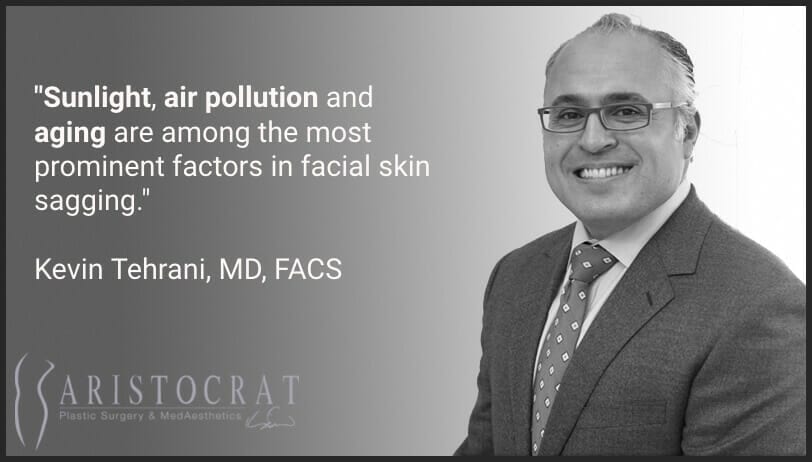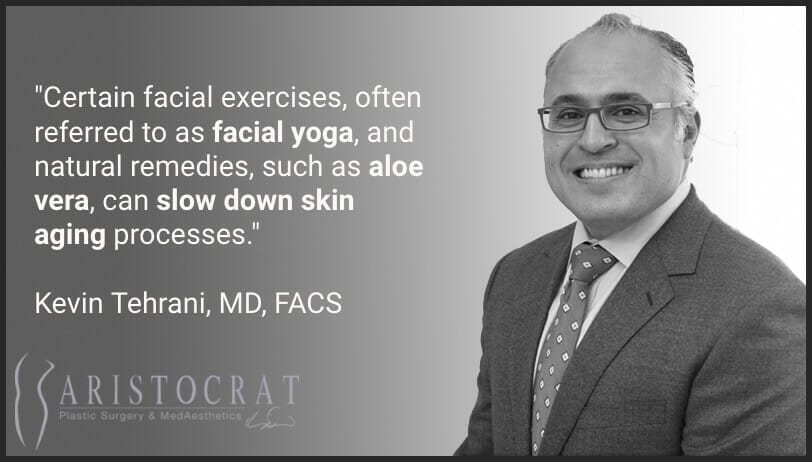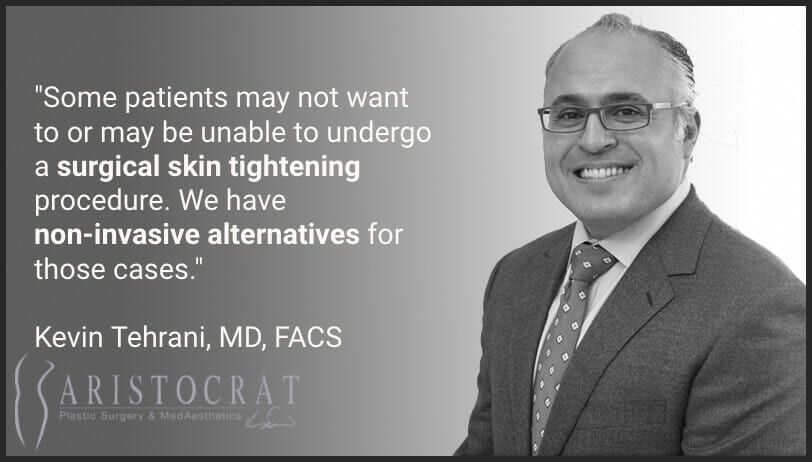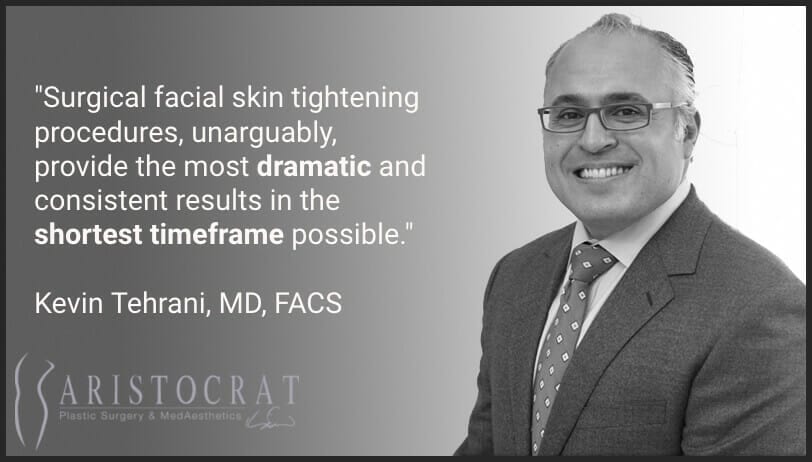How to Prevent Face Sagging When You’re 30
Sagging cheeks and neck is never something you want to see in the mirror. Unfortunately, as our bodies age, we produce dramatically less collagen and elastin—two most important elements responsible for firm, elastic skin.
Luckily, anti-aging skin strategies are some of the oldest problems the humanity has tackled. Even Ancient Egyptians knew about the magical effects of aloe vera—which they used to present to pharaohs as burial gifts, signifying eternal youth.
Over the past 4,000 years, the medicine has moved forward a step or two, and today we have more than just aloe leaves to preserve our skin.
Both non-invasive treatments—such as radiofrequency, ultherapy, laser resurfacing and chemical peels—and surgical measures—such as injections and facelifts—come to arms as the top-of-the-line weaponry in the war against time and gravity.
But first…
WHY DOES FACIAL SKIN BECOME SAGGY?
There are many myths surrounding skin elasticity in the facial area.
These myths include:
- Sleeping on your stomach causes facial skin sagginess
- Jogging or intensive cardio causes skin sagginess
- Certain products and diets can cause skin sagginess
The truth is: skin sagginess occurs naturally with age.
Due to many factors that determine how nicely your skin “fits” on your face, all people will experience at least some skin sagginess along the way.

The main factors that cause facial skin sagginess include:
- Loss of collagen. Collagen is one of the more common types of protein found in our bodies. It can be found in our bones, muscles, tendons and… skin. In the latter case, collagen is responsible for replacing and restoring dead cells in the dermis—the middle layer of the skin. With loss of collagen, skin renewal slows down, and sagging occurs. Collagen levels go down for many different reasons:
- Age. As we become older, our bodies produce less of this vital protein. It is a natural process. Women experience especially dramatic reductions in collagen after going through menopause. After the age of 60, significant reductions in collagen levels are considered normal.
- Smoking. It has been clinically shown that smoking causes significant reduction in collagen levels in the skin. For one, the chemicals contained in the tobacco smoke damage collagen and elastin cells, responsible for skin renewal and elasticity. But even then, the nicotine forces the blood vessels beneath the skin to narrow, slowing down the supply of oxygen and nutrients into the dermis.
- Sunlight. People look wonderful after a couple of weeks at the sunny resort by the sea, right? One of the reasons why their skin looks so rejuvenated is because the ultraviolet rays in the sunlight cause collagen cells to break down faster, producing extra elastin. While this can definitely boost your skin elasticity in the short run, there’s a high chance that the damaged collagen in the dermis will restore incorrectly, causing wrinkles and sagginess.
- High sugar consumption. As with most any bodily function, excess sugar consumption rarely bears good news. The thing is—high sugar diets speed up the glycation process, during which certain molecules, called advanced glycation end products (AGEs), are produced. The bad news is that AGEs suppress and damage nearby proteins, including collagen.
- Genetics. Unfortunately, how well our body produces collagen is also determined by genetic factors. Through affecting the extracellular matrix, our genetics can effectively dictate how much collagen our bodies produce, and how good the collagen we produce actually is (some collagen cells can be mutated.)
- Sudden weight changes. Both dramatic weight loss and weight gain can lead to skin sagginess. The main reason why this happens is because the skin gets stretched out, creating a saggy appearance when a normal weight is reached again. With age, our faces tend to be depleted of facial fat, too, which creates an “excess” of skin.
- Facial muscle degradation. As our facial muscles become weaker and smaller with age, the facial skin has less “area” to cover, creating a sagging appearance.
HOW TO RESTORE FACIAL SKIN ELASTICITY: FROM NATURAL TO SURGICAL OPTIONS
Luckily, there are many ways how you can help yourself restore the facial elasticity you once had.
LEVEL 1: NATURAL REMEDIES, EXERCISES AND DIETS
We’ve titled this the “level 1” option, but, in reality, adjusting your habits and dieting can be one of the hardest things to do for many patients.
In general, natural remedies and tactics work best for patients who:
- Are relatively satisfied with their current facial skin, and are not looking for dramatic change
- Are looking for preventative measures rather than a skin restoration
- Are highly allergic to synthetic treatments and/or cannot undergo a surgery
- Are confident in their ability to change their habits and stick to those changes

NATURAL REMEDY #1: ALOE VERA
When it comes to natural, non-invasive saggy skin treatments, few options can compare to aloe vera.
In fact, aloe vera has been used for medicinal purposes for over 6,000 years. Multiple Ancient Egyptian cave paintings have been found that portray the leaf and its healing properties. The remedy played such an important role that it was titled “the plant of immortality” and gifted to pharaohs as a burial gift.
Nowadays, the plant is still continued to use both casually and professionally in many areas of medicine. Most of the modern skin-tightening remedies include aloe vera, and for good reason.
It has been both clinically and scientifically shown that aloe vera:
- Aloe vera gel significantly reduces facial wrinkles
- Aloe vera improves facial skin elasticity
- Aloe vera cream has increased collagen levels in all patient groups
Another 1998 study has concluded that higher Type-III collagen levels were observed in patients who have been taking aloe vera as either dietary supplement or a skin gel. Not only larger in quantity, the new collagen supplies were also more effective in renewing skin cells and healing wounds.
How to apply aloe vera to your face:
- Pure aloe vera treatment:
- Break the aloe vera leaf in several places to extract a healthy dose of the juice
- Apply the liquid to your face and neck
- Keep the “mask” on for 15-20 minutes
- Wash it off with water
- Repeat the procedure several times a week
- Mixed aloe vera treatment:
- Mix aloe vera juice with mayonnaise and honey (1 tablespoon of aloe vera, 1 tablespoon of mayonnaise, 1 tablespoon of honey)
- Apply the mixture to your face and neck
- Keep the “mask” on for 15-20 minutes
- Wash it off with water
- Splash your face with cold water
- Repeat the procedure once a week
NATURAL REMEDY #2: LEMON
Vitamin C has been shown over and over again to be instrumental in keeping your skin healthy, youthful and elastic.
In fact, most of the skin-related problems (dryness, sagginess, poor wound healing) are associated with depleted levels of Vitamin C.
A major 2017 academic review has concluded that vitamin C directly affects:
- Skin aging. While it is difficult to distinguish the exact effects on natural aging and environmental aging (smoking, UV exposure), multiple studies associate Vitamin C levels with better overall skin health and prevention of certain adverse environmental effects on the skin. The most direct link between Vitamin C and skin health is about preventing early signs of scurvy, for example, include skin fragility, corkscrew hairs and poor wound healing.
- Defence against UV and radiation. Strong links have been established between the adverse effects of UV on overall skin health and its ability to utilize collagen and Vitamin C’s ability to prevent said adverse effects. Vitamins E and C have been shown to repair the skin’s natural defences against UV rays and radiation.
- Dry skin. The skin’s ability to retain humidity gradually lowers with age, but it can also be caused by environmental and medical factors, such as illnesses, certain supplements and medications, environmental temperature, air flow and humidity. Vitamin C is considered instrumental in specific cellular processes that ultimately affect the skin’s ability to retain liquids.
How to use lemon to reduce skin sagginess:
- Use the lemon:
- Take a slice of a lemon
- Start rubbing the slice on your face and neck
- Squeeze the lemon during the process to make sure there’s enough juice
- Do this for 5-10 minutes
- Let the juice dry out on your face
- Repeat 1-3 times a day
- Use lemon juice:
- Squeeze the juice out of a half of a lemon
- Pour the juice into a cup of chilled water
- Splash the mixture onto your face
- Let it air-dry during the next 5-10 minutes
- Repeat 1-2 times a day
NATURAL REMEDY #3: HEALTHY HABITS
Besides applying natural mixtures onto your facial skin, there are a lot of everyday changes you can make in your diet and habits that will have a lasting impact on your skin’s elasticity and health.
The most important thing you can do as far as habits go is to fix your diet.
As we’ve established earlier, skin sagginess occurs mostly due to the natural depletion of collagen from your body. Luckily, there are foods that specifically help your body produce more collagen.
You might have heard that bone broth is effective in helping your body maintain collagen levels. Don’t worry, there are other options:
- Kiwi. Rich in Vitamin C, an important element in collagen production.
- Berries. Rich in Vitamin C and antioxidants, which help prevent breakdown of collagen.
- Almonds. Rich in Vitamin E, essential to neutralize free radicals damaging collagen cells.
- Avocados. Has Vitamin E and antioxidants.
- Carrots. Rich with Vitamin A, which helps restore and renew collagen in damaged skin.
- Sweet potatoes. Rich with Vitamin A, which helps restore and renew collagen in damaged skin.
- Squash. Rich with Vitamin A, which helps restore and renew collagen in damaged skin.
- Apricots. Rich with Vitamin A, which helps restore and renew collagen in damaged skin.
- Cantaloupe. Rich with Vitamin A, which helps restore and renew collagen in damaged skin.
- Mangos. Rich with Vitamin A, which helps restore and renew collagen in damaged skin.
- Spinach. Rich with Vitamin A, C and E.
- Kale. Rich with Vitamin A, C and E.
- Green beans. Rich with Vitamin A, C and E.
- Broccoli. Rich with Vitamin A, C and E.
- Garlic. Rich with sulfur, which helps prevent the breakdown of collagen cells.
- Oysters. Rich with zinc, an essential trace mineral that stimulates collagen synthesis.
- Tomatoes. Rich with lycopene, an amino acid that protects the skin from UV exposure.
Besides filling your diet with greens, nuts and fruit, there are physical facial exercises you could do to prevent sagging skin:
- The “Lion Face”. This particular “facial yoga” pose helps you tighten your facial muscles and improve the facial muscle tone. Here’s how it goes:
- Close your eyes, inhale slowly
- Scrunch your face, as if you were trying really hard at something
- Stick your tongue as far out as possible while exhaling
- Wide-open your eyes and raise your eyebrows as far up as you can
- The “Forehead Stretch”. If you’ve ever considered a facelift, you know how it goes: some excess skin is removed behind your ears, and the whole face is “pulled” backwards. This is essentially what you do during this exercise:
- Place your hands near your temples
- Spread your fingers a little wide, pressuring your hairline
- Pull the skin backwards until it is fully stretched
- Raise your eyebrows as far up as you can
- Hold this position for 5 seconds, repeat 5 times
- The “Cheek Stretch”. This particular exercise helps with the cheek muscle tone. Basically what you do is stimulate your cheek muscle activity with your fingers. Here’s how it goes:
- Place your index fingers in the middle of each cheek
- Press firmly down on your skin and make small circles using your index fingers.
- Push your lips outward into an “O” shape, then pull your lips back to make a wide smile.
LEVEL 2: NON-INVASIVE TREATMENT OPTIONS
Here at Aristocrat Plastic Surgery, we’re always for natural remedies and healthy habits. The best treatment is prevention, period.

However, what if you’re in your 40s and are already seeing the first results of air pollution and sunlight damage? What if it’s “too late” for natural remedies, and you’re looking for something that could produce results here and now?
There is a range of treatments that combine the best of both worlds: they’re non-invasive—which means no scars and no risk of complications—yet they still get the job done. Not as efficiently as surgical treatment, but efficiently nonetheless.
The main advantages of non-surgical treatments are evident:
- Little-to-no recovery downtime. While laser resurfacing and chemical peels may require a week or two of “social downtime”, there are options like radiofrequency (RF) therapy that will enable you to leave the office unscathed and continue with your life as if nothing happened.
- No complications. It is no secret that surgical procedures of any scope and size always come with certain risks. While you’re in good hands here at Aristocrat, not every surgeon will ensure your safety and smooth recovery. If you’re unsure about your doctor’s qualifications or integrity, best stick to non-invasive options.
- Quick and easy. Most non-invasive skin tightening procedures should take no more than an hour. No anaesthetics are going to be used, which means that you’ll be able to drive back home. While you may not go back to the office or go on a date the same day, non-invasive options will require a lot less overall time commitment on your part.
That being said, there are limitations to non-invasive skin tightening technologies used today:
- They can only tackle mild-to-moderate sagging. Due to the nature of how non-invasive technologies work, they are most effective with small to moderate amounts of sagging. Radiofrequency, chemical peels and laser technologies will simply not be enough to fix large amounts of sagging.
- They will work for some patients better than others. While surgical procedures are consistent in their outcomes for all patients, non-invasive technologies will highly depend on a number of factors, such as the patient’s skin pigmentation and overall skin health.
- They take their time to show up, and last for up to a year. Surgical facial skin tightening procedures will produce immediate results and will last much longer than non-invasive options. That’s just the reality of non-invasive treatments: they need several sessions over several weeks to produce results, which are relatively temporary.

Nevertheless, if you believe non-invasive facial skin tightening is the best choice for you, here are the options used today:
- Radiofrequency (RF) therapy. The radiofrequency device uses radio-frequency wave lengths to heat the deeper layers of your skin, stimulating collagen production.
- FDA cleared: Yes
- Recovery downtime: No
- Skin types: All
- Anaesthesia used: Very Rarely (Local)
- Results appear: Gradually, over 1-2 months
- Treatments required: Usually 2-6
- Procedure type and duration: Up to 1 hour, in-office
- Ultherapy. Ultherapy facial skin tightening is similar to to the radiofrequency technology, only that a different type of wavelength is used. The results are similar: the ultrasound waves heat up the deeper layers of the skin, stimulating collagen production.
- FDA cleared: Yes
- Recovery downtime: No (sometimes some mild redness, irritation and numbness may occur)
- Skin types: All
- Anaesthesia used: No
- Results appear: Gradually, over 2-3 months
- Treatments required: Usually 2-6
- Procedure type and duration: 45-90 minutes, in-office
- Microneedling. Microneedling is the new hot technique in skin tightening today, and for good reason. The technology works by inserting a minuscule needle into the skin multiple times, creating small “injuries.” This stimulates the skin’s natural healing processes, which ultimately leads to a smoother, healthier skin.
- FDA cleared: No
- Recovery downtime: No (sometimes some mild redness, irritation and numbness may occur)
- Skin types: All
- Anaesthesia used: Very Rarely (Local)
- Results appear: Gradually, over 2-3 months
- Procedure type and duration: 3 stages, 20-day overall course
- Combined with: Radiofrequency (RF) treatment
LEVEL 3: FACELIFT AND BOTOX®
For patients with most skin sagging, preventionary measures and non-invasive options may simply not be enough.

Luckily, we have surgical and botulinum toxin options that can produce the dramatic change you’re looking for:
- Facelift is a major invasive procedure, during which a portion of the facial skin is surgically removed, creating a tighter, smoother appearance. Here are a few important facts about facelifts:
- Facelifts are often combined with neck-lifts
- From mini facelifts to full facelifts, the procedure’s scope can be adapted to your individual needs
- Facelift scars are usually “hidden” behind the ears
- It usually takes about 2 weeks for the swelling and bruising to go away, allowing you to get back to your normal regimen
- Facelift results are lasting and can even be called permanent
- Read more about facelifts here.
- Botox®—or botulinum toxin—injections are the second most popular procedure to tackle sagging skin. During the procedure, is injected into target muscles, causing relaxation and smoother appearance. Here are the most important facts about injections:
- Botox® injection procedures take up to 30 minutes usually
- Botox® injections are becoming increasingly more popular among men
- Botox® is not a good procedure against sun damage
- Botox® injections are considered extremely safe, although they can lead to a slightly “over-tuned” appearance
FINAL VERDICT: IF YOU DON’T HAVE TIME FOR NATURAL REMEDIES, VISIT OUR CLINIC
There is thousands’ of years worth of medical knowledge in natural remedies described in this article. They’re invaluable, and should be used regularly—whether your skin has started giving in to gravity or not.
However, not all of us have the time or the patience to wait for the creams and gels to take effect. Some of us need results, now.
In those cases, there are two options: invasive, or non-invasive.
Invasive options usually mean a full or partial facelift, during which a part of your facial skin is simply removed through small incisions, creating a tighter, more youthful appearance. The effects of a facelift are effective as they are consistent.
If you think that’s too much, then you might explore non-invasive options, such as radiofrequency therapy, ultrasound therapy, microneedling or chemical peels. All of them can work, but it is almost a given that they’ll take several sessions and at least a few months to produce noticeable results.
Non-invasive options also last up to a year, thus it would be a mistake to consider their effects permanent.

